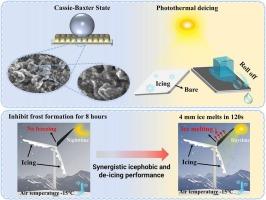Sunlight-activated spinel CuFeMnO₄/carnauba wax composite: Synergistic photothermal-superhydrophobic coating for anti-icing and ultrafast deicing
IF 6.1
2区 材料科学
Q1 MATERIALS SCIENCE, COATINGS & FILMS
引用次数: 0
Abstract
Ice crystal accumulation threatens the safety of power, aerospace, and transportation infrastructure, driving the need for advanced anti-icing strategies due to the limitations of conventional deicing methods. A photothermal-superhydrophobic bifunctional composite coating was developed by integrating spinel CuFeMnO4 with bio-based carnauba wax (i.e., CFMO/CW). It exhibits efficient light absorption, achieving over 96.7% absorption across a broad spectral range of 250–2500 nm. The coating achieves stable Cassie-Baxter non-wetting behavior, characterized by a water contact angle (WCA) of 155.0° ± 0.9° and a sliding angle (SA) of 3.2° ± 0.2°. Additionally, it demonstrates a significant 486-fold delay in ice nucleation under conditions of −15 °C, lasting 47,689 s, compared with the bare aluminum (Al) plate (98 s). Under 1-sun irradiation, the coating's surface temperature rises by 65.6 ± 0.9 °C within 600 s, enabling it to melt 4 mm of ice within 120 s for rapid deicing. Additionally, the coating significantly inhibits frost formation by evaporating water droplets at 0.2-sun intensity. The CFMO/CW coating demonstrates excellent environmental durability and mechanical robustness, effectively resisting corrosion from strong acids and bases (pH = 1–13), and 3.5 wt% saline solutions. Even after 60 cm of sandpaper abrasion and 10 cycles of tape peeling, it retains its superhydrophobic surface and low sliding angle. This synergistic system integrates energy-efficient photothermal conversion with passive icephobicity, offering a sustainable and effective alternative to traditional deicing methods for applications in extreme environments, such as power infrastructure and aerospace surfaces.

阳光活化尖晶石CuFeMnO₄/巴西棕榈蜡复合材料:用于防冰和超快除冰的协同光热-超疏水涂层
冰晶积累威胁着电力、航空航天和交通基础设施的安全,由于传统除冰方法的局限性,推动了对先进防冰策略的需求。将尖晶石CuFeMnO4与生物基巴西棕榈蜡(CFMO/CW)结合,制备了光热-超疏水双功能复合涂层。它具有高效的光吸收,在250-2500 nm的宽光谱范围内实现超过96.7%的吸收率。该涂层具有稳定的Cassie-Baxter不润湿性能,其水接触角(WCA)为155.0°±0.9°,滑动角(SA)为3.2°±0.2°。此外,在- 15°C条件下,与裸铝(Al)板(98 s)相比,它的冰形核延迟了486倍,持续时间为47,689 s。在1次太阳照射下,涂层表面温度在600秒内上升65.6±0.9°C,使其能够在120秒内融化4毫米的冰,实现快速除冰。此外,涂层通过在0.2太阳强度下蒸发水滴来显著抑制霜的形成。CFMO/CW涂层具有优异的环境耐久性和机械坚固性,可有效抵抗强酸、强碱(pH = 1-13)和3.5 wt%盐水溶液的腐蚀。即使经过60 cm的砂纸磨损和10次的胶带剥离,它仍然保持其超疏水表面和低滑动角。这种协同系统将节能光热转换与被动憎冰性相结合,为电力基础设施和航空航天表面等极端环境中的传统除冰方法提供了可持续和有效的替代方案。
本文章由计算机程序翻译,如有差异,请以英文原文为准。
求助全文
约1分钟内获得全文
求助全文
来源期刊

Surface & Coatings Technology
工程技术-材料科学:膜
CiteScore
10.00
自引率
11.10%
发文量
921
审稿时长
19 days
期刊介绍:
Surface and Coatings Technology is an international archival journal publishing scientific papers on significant developments in surface and interface engineering to modify and improve the surface properties of materials for protection in demanding contact conditions or aggressive environments, or for enhanced functional performance. Contributions range from original scientific articles concerned with fundamental and applied aspects of research or direct applications of metallic, inorganic, organic and composite coatings, to invited reviews of current technology in specific areas. Papers submitted to this journal are expected to be in line with the following aspects in processes, and properties/performance:
A. Processes: Physical and chemical vapour deposition techniques, thermal and plasma spraying, surface modification by directed energy techniques such as ion, electron and laser beams, thermo-chemical treatment, wet chemical and electrochemical processes such as plating, sol-gel coating, anodization, plasma electrolytic oxidation, etc., but excluding painting.
B. Properties/performance: friction performance, wear resistance (e.g., abrasion, erosion, fretting, etc), corrosion and oxidation resistance, thermal protection, diffusion resistance, hydrophilicity/hydrophobicity, and properties relevant to smart materials behaviour and enhanced multifunctional performance for environmental, energy and medical applications, but excluding device aspects.
 求助内容:
求助内容: 应助结果提醒方式:
应助结果提醒方式:


